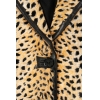|
 A button was the first clothes fastener invented by humans.
The buttons appeared to be the most durable of them. Whatever is offered by
fashion brands from season to season as trendy zippers, Velcro fasteners or
rivets, the buttons take hold of the position firmly in fashion industry. This
is not a functional detail but the decorative accessory which sometimes live on
their own, somewhere else but clothes. A button was the first clothes fastener invented by humans.
The buttons appeared to be the most durable of them. Whatever is offered by
fashion brands from season to season as trendy zippers, Velcro fasteners or
rivets, the buttons take hold of the position firmly in fashion industry. This
is not a functional detail but the decorative accessory which sometimes live on
their own, somewhere else but clothes.
The Wikipedia defines the button as the clinch on the
clothes designed to bind the parts. A button on the one part of the clothes is
put into the buttonhole (loop) fastened to the other part of the same clothes
and fastening is done so. Such a detailed description of button function is
likely provided for further generations who are likely invent something more
practicable and durable and comfortable than buttons.
The first buttons with the utilizing function to fasten were
invented by the pragmatic Germans in the 18th century. Archeologists discovered
many interesting diggings that relate to the third millennium B.C. in India and
China. As the scientists believe such things are more reasonable to refer to
decorative elements than to fasteners. They were paid too much attention to
decorate the clothes with only buttons.
Privileges for men
It is curious that buttons were considered to belong to the
men’s wardrobe only. Gradually fashion designers used buttons with female wear
either but to the smallest extent. There is a myth evidenced as the real fact that
one of Italian lawyers brought a case against a high society lady for the
reason that she had too many buttons of her attire. However, the lady was too
cunning to win the case. She managed to prove that the buttons on her dress
were not buttons as they are since they have no buttonholes or other fastening
details but only ornamental elements.
During the Age of the Enlightenment the technique to make
buttonholes was completely mastered, though the clothes with many rows of
buttons on a long male jacket with only two tabs at the collar was deemed high
style. Noblemen used to wear clothes with buttons made from gold, silver,
corals, amber, and pearls. However, buttons did not survive as the luxury
details. The first strike to the status of lavish buttons was made by some
Mathew Bullton from London. He opened a shop in 1767 trading in imitated
buttons made from ordinary materials but completely imitating the precious
ones.
Royal approach to buttons
Victoria, the Queen of Great Britain, set another impulse to
fashion industry. As a widow, she signed a special decree on the funeral ritual
regulations. She accentuated on the condition for all widows to wear opaque
black buttons when doing funerals. The buttons for the Queen were made from
agate stone. And then plain buttons from glass of dark color or just covered
with a black fabric were offered for other women.
The fashion
designer Elsa Schiaparelli first used plastic buttons in her fashion collections.
The professional chemist Jean Clément supported her in her business. Jointly
they manufactured a huge assortment of colored buttons shaped as lemon, orange,
grapefruit, ballet dancer, spoon, Cristmass bell, horses, paper clips and etc.
as the convinced surrealist in fashion industry, Elsa Schiaparelli was of the
opinion that buttons are the items to fasten to whatever area, even the crown
of a lady’s hat.
Uniqe buttons
The German Company
Van Laack specializes in manufacture of quality men’s shirts. The zest of the
brand is the button with three holes. They are made manually from the pearl.
The buttons
for the traditional Chinese wear are made from the narrow edge. They are skillfully
folded as the «knobs» and then fastened to clothes.
Hand-made
masters of today also commit to the button industry. The make exclusive designer
buttons from wood, ceramics, self-hardening plastic and other natural
materials. Some of those designers trade online for about 4 dollars a piece.
|